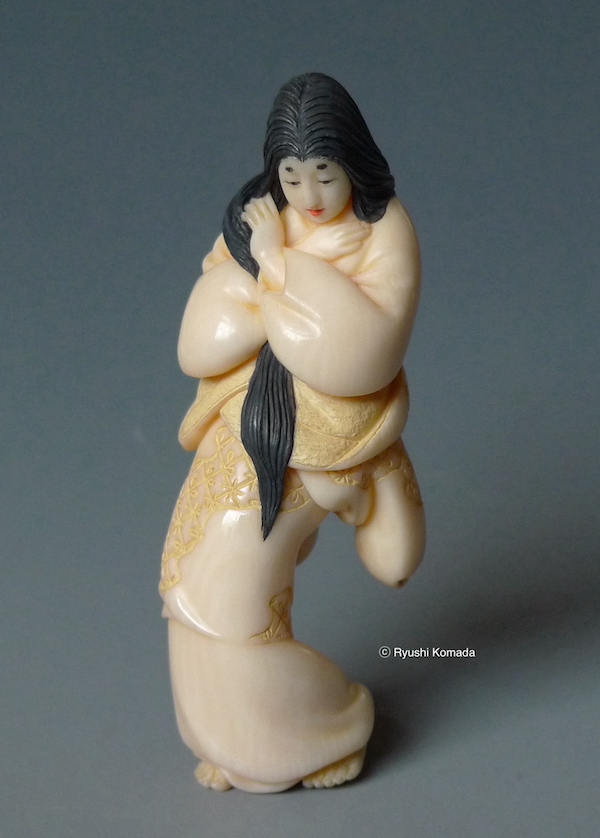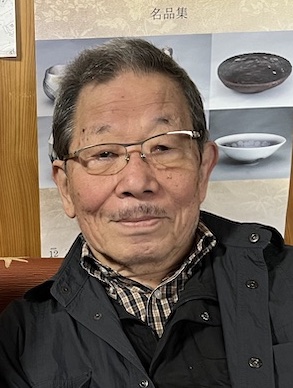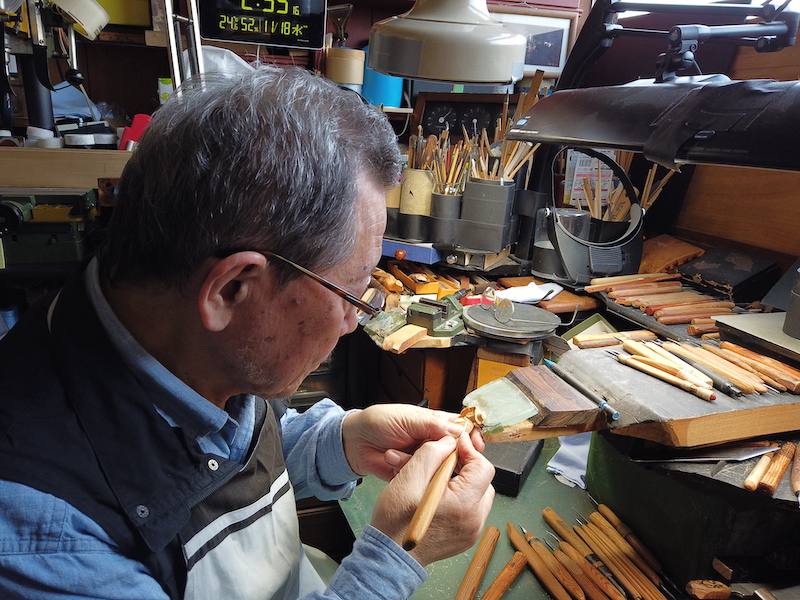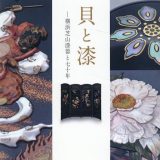Note: In this website, Japanese names are given in the Japanese order: family name first.
Brief biography of Komada Ryushi
Komada Ryushi was born in Tokyo in 1934 as Komada Isamu. At the age of 15 he started studying the art of carving ivory okimono (statuettes) under his father Ryusui, who excelled at female figures dressed in kimono. Incidentally, Ryushi’s grandfather Haruyuki/Ryusai and his uncle Yoko were also okimono carvers who were good at human figures.

Ryushi became independent in 1962 when he got married. Two years later he began studying and carving netsuke. His first solo exhibition was held in Los Angeles in 1981, followed by one in Tokyo in 1992.
As a netsuke artist, Ryushi makes the most of his knowledge and skills in carving female figures which he learned from his father. It has been claimed that “of all times and places, nobody came close to Ryushi in carving beautiful women.” He also carves a wide range of subjects including male figures, children, and animals. Successfully making use of his ivory carving techniques, he employs a variety of materials such as mammoth tusk, stag antler, boxwood, various woods from overseas, as well as black coral.


Ryushi, together with Saito Bishu, Tachihara Kangyoku, and Sakurai Hideyuki, initiated the “contemporary netsuke” movement at the beginning of the 1970s, establishing Netsuke Kenkyukai in 1977, which is known today as the International Netsuke Carvers’ Association. From 1994 to 2004, Ryushi served as president of the Association. In this capacity he facilitated the exchange of information among netsuke artists. He also promoted contemporary netsuke among the general public by organizing exhibitions, giving lectures and holding carving demonstrations in Japan and overseas.

Furthermore, Ryushi devoted himself to nurturing young artists, unstintingly sharing his carving and tool-making techniques, as well as his knowledge of netsuke in general. He gave classes in netsuke carving together with the artist Kuroiwa Akira at the Asahi Culture Center in Shinjuku, Tokyo, from 2000 to 2020. He also held lessons at the Community Club Tamagawa in Futako Tamagawa, Tokyo, and at Sankei Gakuen in Shin Yurigaoka, Kanagawa Prefecture. Some of the students have become professional netsuke artists.
For his netsuke titled Afternoon, Ryushi was awarded the “Incentive Prize by the Minister of Education, Science and Culture” at the 22nd Japan Ivory Sculpture Exhibition in 1999. He also received the “Golden Dragon Award” by the Kinsey International Art Foundation in April 2009 and the “Bronze Hakutaku Award” by the International Netsuke Society in July 2009 for his achievements as a netsuke artist over the years and his efforts in passing on the art of netsuke carving to the next generation.

In this carving, a woman is ringing a small bell in her hand, while playing with a cat at her feet in the afternoon.
In March 2017, for the opening of a netsuke exhibition in Washington DC, Ryushi gave a talk and carving demonstration with his daughter Makiko at the Japan Information & Culture Center of the Japanese Embassy, as well as at the Smithsonian’s Freer Gallery. His interview was live-streamed on the Facebook of NPR (National Public Radio).
NPR Facebook Live (about 30 minutes)
In this video, Ryushi demonstrates how he uses certain tools including hidari-ba (left-blade) scrapers.
https://www.facebook.com/NPR/videos/10155411098656756/
Note: If the above link does not work, please try this:
https://m.facebook.com/NPR/videos/10155411098656756/
Article of the NPR with a short video (about 2 minutes)
This article includes photos of Ryushi’s carving tools, as well as those of several antique netsuke displayed at the netsuke exhibition held in the Japanese Embassy, Washington DC.
https://www.npr.org/2017/04/01/522120453/in-the-art-of-netsuke-tiny-toggles-tell-delightful-stories-of-japan/
Ryushi has been carving for over 70 years, during which he has continued to improve his skills and tools that he makes for himself and others. In recent years, he has devoted himself to sharing his knowledge and experience through videos which are available at his daughter’s website, Koryuen (Netsuke Carving section: http://koryuen-jp.com/en/e-carving/).

Material: boxwood; Height: 5.4 cm
This netsuke appears in the NPR video and article mentioned above when it was still in the process of manufacture. The photo here shows the finished object.
Major public collections
HIH Prince Takamado Collection, Tokyo National Museum
The University Art Museum, Tokyo University of the Arts
Mishima Taisha Shrine (Shizuoka prefecture)
Kyoto Seishu Netsuke Art Museum
National Museums Liverpool (UK)
Text and photos by Komada Makiko


